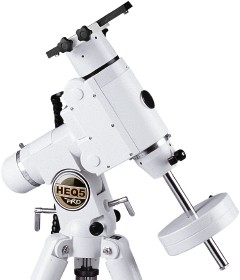First impressions: Sky-Watcher HEQ5 Pro
So I now own a Sky-Watcher HEQ5 Pro equatorial mount; I ordered it earlier this month through Focus Scientific and picked it up on the 17th. I’ve had it out twice so far to run it through its paces, and I have to say I’m impressed.
 Compared to our Celestron NexStar 5 SE, this thing is built like a tank; the NexStar suddenly feels very flimsy. Definitely a step up in quality and robustness. It’s heavier, of course, and as such a bit harder to carry. Mounting my three-kilogram Equinox 80 refractor on it is almost an insult to its 14-kilogram capacity: I had to use only one of the two 5.1-kilogram counterweights, and to balance it I had to move it almost to the top of the counterweight shaft. Suffice to say the scope didn’t vibrate much.
Compared to our Celestron NexStar 5 SE, this thing is built like a tank; the NexStar suddenly feels very flimsy. Definitely a step up in quality and robustness. It’s heavier, of course, and as such a bit harder to carry. Mounting my three-kilogram Equinox 80 refractor on it is almost an insult to its 14-kilogram capacity: I had to use only one of the two 5.1-kilogram counterweights, and to balance it I had to move it almost to the top of the counterweight shaft. Suffice to say the scope didn’t vibrate much.
I was concerned that there would be a problem when my full lunar imaging train was added — i.e., the scope, extension tube, Powermate and camera. Not so much with the mount, but with the scope’s bracket. I thought I would have to remove the bracket and make use of a standard Vixen-compatible dovetail and rings. Not so: the whole setup was still stable, and I was able to get a pretty good photo of the Moon on the second night of testing. Not that I need an equatorial mount for such short exposures, but its rocklike stability made it much easier to focus.
Sky-Watcher’s computerized mounts use the SynScan hand control. It sort of resembles Celestron’s remote, but it’s got a different feature set that I still haven’t really explored. It was still intuitive enough for me to operate without, well, reading the manual. There are fewer sync options — you don’t have Celestron’s SkyAlign or solar system alignment. On neither night did I bother with precise polar alignment — I’m saving that lesson for another night — but on the first night I was a fair bit closer than on the second. On that first night, the alignment was scarily accurate — more than I had come to expect from the NexStar. The second night’s alignment was less accurate but still usable. Clearly a good rough polar alignment helps. (I should mention that I used a 12.5-mm reticle eyepiece during the alignment process, and that I tried both two-star and three-star alignments.)
I also bought the mount’s GPS receiver, which uses a GPS fix to provide the mount’s computer with its date, time and location — quicker, more convenient and almost certainly more accurate than adding it manually, which I would otherwise have to do. The controller recognized the GPS as soon as I turned on the power, and the GPS worked very quickly after that; the only thing I had to provide was the time zone.
One problem I encountered had nothing to do with the mount: when pointed near the zenith, the Equinox’s focuser started slipping out, even with the focus locked down. Hopefully I only need to tighten a screw here or there; otherwise, I’m going to have to take it into the shop.
Other than that, so far, so good. Next I have to figure out how to do a proper polar alignment.
(SkyNews reviewed the HEQ5 Pro, along with its big brother, the EQ6 Pro, and two earlier iterations of Sky-Watcher’s apo doublets, in its May-June 2006 issue. And a note to any American readers: in the U.S., the equivalent to the HEQ5 Pro is Orion’s Sirius EQ-G, for which a GPS receiver is also available.)
Previously: Equatorial mounts and polar alignment; Gearing up for astrophotography.